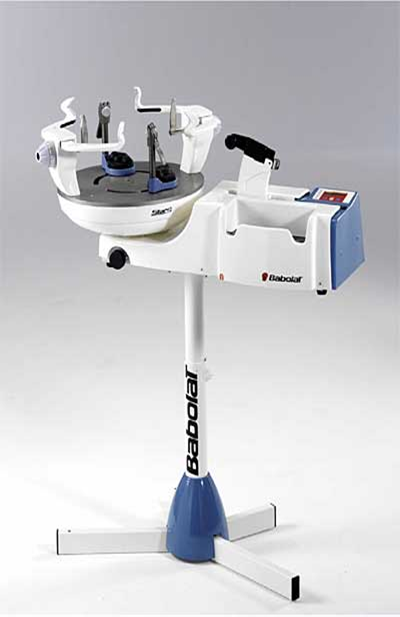|
|
| 
 |
|
 Machine: Machine:
Your racket will be stung on a Babolat Star 5 machine, the latest incarnation of Babolat's iconic Star series. Babolat machines are a mainstay in the stringing rooms of ATP and WTA tour events. The Star 5 is widely used on tour, for example at the ATP Masters 1000 Montreal.
The Star 5 is an electronic machine, has a secure 6 point mounting system, a diablo to reduced stress on the string and is accurate to 1/10 of a kilo.
String tension:
String tension is an easy concept to understand. Higher tensions give more control. This is because when a ball impacts against tight strings it is compressed more and loses more energy. Higher tensions also give more spin and a crisper feel. Looser tensions give more power. This is because when a ball impacts against loose strings, it is compressed less and more energy can be stored in the strings and returned to the ball. Looser tensions also give a bigger sweetspot and reduce shock and vibration.
The average tension range for modern tennis racquets tends to be around 50-60 lbs (22-27). Whilst more recreational players tend to stick with the middle tension, professional players have been known to use a very wide range of tensions, from 10 kg (Filippo Volandri) to 44 kg (Monica Seles).
Professional players are also known to fine tune their tensions depending on the surface they are playing on and the weather conditions; often making changes of only 1 or 2 lbs. However, such small changes are unlikely to make a big difference; research has found that it takes a 25% reduction in string tension to achieve a 2% increase in shot speed for grounstrokes. This 25% decrease in tension is even less beneficial for the serve, resulting in only a 1% increase in speed.
String types:
There are many different constructions of strings available on the market today. But what is really important is how many individual fibers are used to make the string. Some strings are made from just one single fiber, while others are made from thousands of tiny fibers twisted or woven together to make one piece of string. The aforementioned strings represent the extreme ends of the spectrum, and there are countless variations in between.
Monofilament (a.k.a. Polyester)
This is a string made from one single piece. It is the most simple and least expensive construction. You simply extrude a single fiber of string, package it and it is ready for sale. There is no complicated wrapping or bonding of fibers together.
The advantages of such a construction are that it is inexpenisve to make; and is durable, because it is a single, thick piece of string that takes longer to cut through. The main disadvantage is that it is the least comfortablee construction, because it gives less on impact than a string made of many fibers. This type of string is not advisable for beginners or young players.
Solid Core With Wraps (a.k.a. Synthetic Gut)
As the name suggests, these strings have a single piece of string at their centre, surrounded by layers of smaller fibers. The number of outer layers will vary, but generally the more layers of wraps there are, the thinner the string core will be.
The advantages of this construction are that the core makes the string more durable and able to maintain tension better; the outer wraps give more on impact, making the string feel softer: and it is relatively inexpensive as not too many fibers are being put together. The disadvantages are that as the core gets thinner, it tends to get weaker and breaks easier; they are more expensive than monofilaments, and comfort is not enhanced as much as it can be with more fibers. This type of string is the most popular on the market.
Multifilament
These strings are made of many small fibers. This makes them the most difficult strings to make because there are so many fibers to be twisted and bonded together.
The advantages of these strings are that they are the most comfortable because they stretch the most on impact, they are great for tennis elbow, and the fact that they are softer means more ball cushioning and more depth of shot. The main disadvantage of this construction is that it is less durable because the tiny fibers are easier to break through and more of the strings thickness is made up of the resin that bonds the fibers together.
Aramid
Aramid is the name given to strings made out of Kevlar. Popular in the 1990s, aramid strings have fallen out of favour since the introduction to the market of monofilament polyester strings.
Kevlar strings have the advantage of being incredibly durable. On the down side, they are very stiff and provide little power. This type of string is pretty much obsolete now, and has been replaced by polyester.
Natural Gut
Natual gut strings are made from the intestines of cows; specifically the serosa, which lines the wall of the intestines. These strings are coated to reduce their tendency to unravel.
The advantages of natural gut strings are that they have the best feel, comfort and power due to their high elasticity; and the highest tension maintenance of any string construction. The disadvantages are a relative lack of durability; high manfacturing costs; and vulnerability to the elements. Not recommended for vegans!
 |
|














